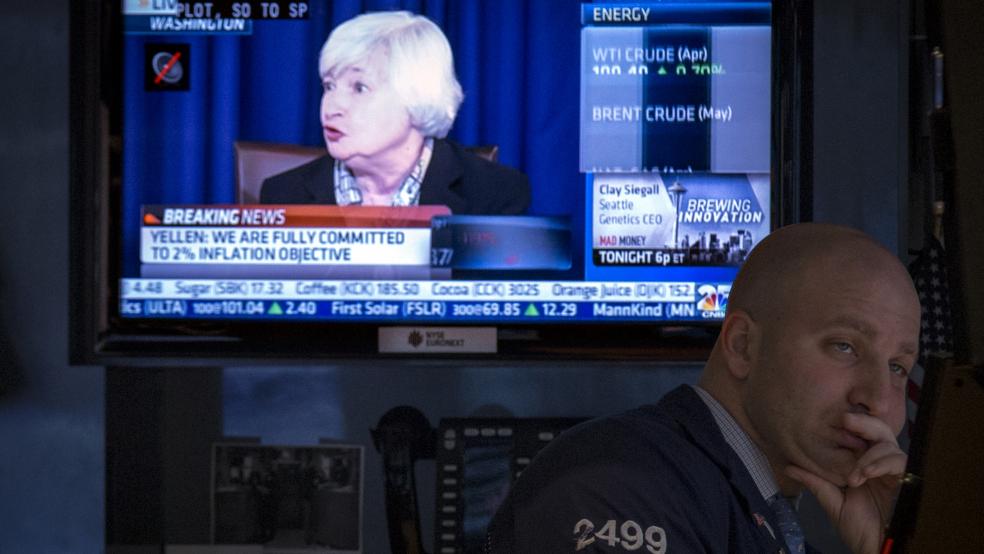Janet Yellen just moved the goalposts. Where to isn’t quite clear.
As expected, Yellen and the rest of the Federal Open Market Committee laid out new guidance for when the central bank’s policymakers might start to raise key short-term interest rates. The FOMC statement released Wednesday specified that rates would be kept where they are “for a considerable time” after the Fed’s monthly bond-buying program ends, likely late this year. At her press conference, Yellen clarified what considerable means: “around six months.”
In a market eagerly listening for specifics it could latch onto, that was enough to send stocks tumbling and bond rates spiking on concern that the Fed's timetable had accelerated a bit.
Related: Highlights of Yellen's Remarks
It’s worth noting the full context of her comments, though. Yellen said that if the Fed’s asset purchase program continues to wind down at its current rate — not a certainty in itself — it would end sometime in the fall of this year. The FOMC, she said, would hold rates steady for a “considerable period” after that.
Asked what a considerable period would look like, she said:
This is the kind of term that’s hard to define but probably means something on the order of around six months or that type of thing, but what the statement is saying is that it depends what conditions are like. We’d need to see where the labor market is. How close are we to our full employment goal? That will be a complicated assessment not just based on a single statistic. And how rapidly are we moving toward it? Are we really close and moving fast? Or are we getting closer but moving very slowly? And then, what the statement emphasizes, and this is the same language we used in December and January, we used the language “especially if inflation is running below our 2 percent objective.” Inflation matters here, too. Our general principle tries to capture that notion. If we have a substantial shortfall in inflation, if inflation is persistently running below our 2 percent objective, that is a very good reason to hold the funds rate at its present range for longer.
Policymakers had been linking future interest rate increases to specific thresholds for the unemployment rate and the outlook for inflation. They had said they’d hold interest rates low “well past” the point that unemployment dropped to 6.5 percent, so long as inflation looked to stay below 2.5 percent. But the unemployment rate fell faster than the Fed expected and, at its current 6.7 percent, could reach the Fed’s target quickly. Yet the Fed doesn’t plan on raising rates any time soon.
In short, the numerical target no longer holds meaning, so the Fed ditched it. At her press conference Wednesday afternoon, Yellen explained: “Markets want to know, the public wants to understand, beyond that threshold, how will we decide what to do?”
The answer still isn’t completely clear. The Fed did say it would look at more qualitative factors in determining when to start raising rates. The FOMC statement said that the committee would “take into account a wide range of information, including measures of labor market conditions, indicators of inflation pressures and inflation expectations, and readings on financial developments.” How’s that for transparency?
At her press conference, Yellen did specifically cite a broader measure of unemployment and underemployment known as U-6, which includes people who have part-time work but would prefer full-time jobs. She also mentioned long-term unemployment among the indicators on her economic dashboard. “We know we’re not close to full employment, not close to employment consistent with our mandate,” she said.
The Fed’s new approach is just the latest in a series of communication strategies. As part of a quest for transparency started under Yellen’s predecessor, Ben Bernanke, the Fed has tried to more clearly signal its intentions for interest rates.
After it dropped interest rates to near zero in 2008, the FOMC initially used only the vaguest of terms — "some time" or "an extended period" — to explain how long they would stay so low. Then, the Fed tied its rate forecasts to the calendar, saying it expected to keep rates exceptionally low “at least through late 2014” or “at least through mid-2015.” Those dates matched up with forecasted improvements in economic projections and the labor market, but they were imprecise at best. The dates didn’t matter as much as the underlying economic conditions the Fed was targeting. So in December 2012, the Fed shifted its communication strategy and began explicitly linking monetary policy to those specific thresholds for unemployment and inflation.
With those specific guideposts now gone, Fed watchers are left to interpret the FOMC statement and Yellen’s words — and many of them saw hawkish signs. The Fed statement, for example, signaled that the economic recovery is now strong enough “to support ongoing improvement in labor market conditions.” Fed officials dropped their forecast for the unemployment rate at the end of this year to a range of 6.1 percent to 6.3 percent, down from 6.3 percent to 6.6 percent in the December forecasts. And 13 of 16 Fed officials now expect the central bank to raise rates in 2015, with a majority of officials now expecting the Fed funds rate to be above 1 percent at the end of 2015.
At her press conference Wednesday afternoon, Yellen tried to emphasize the leeway inherent in those forecasts. “The end of 2016 is a long way out,” she said. “Monetary policy will be evolved to reflect evolving conditions in the economy.”
With the Fed now using qualitative measures that are less well defined, getting that message across might be more of a challenge.
Top Reads from The Fiscal Times:






